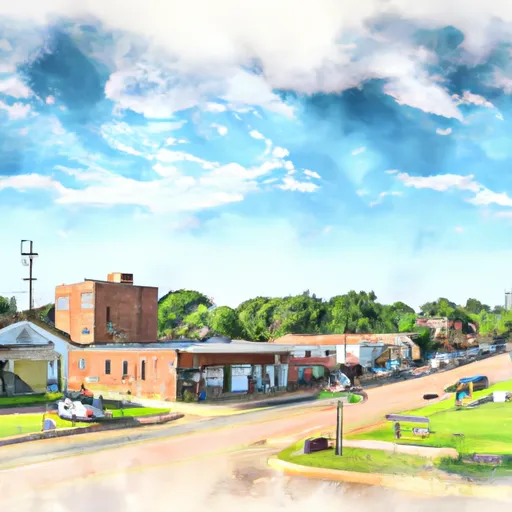-
 Snoflo Premium
Snoflo Premium
Get unlimited access to all our content
With no Ad interruptions! - Start Your Free Trial Login with existing account
Sherrill
Eden Index
Climate
7.8
•
Recreation
5.4
•
Community
•
Safeguard
5.0/10

Sherrill, Arkansas is a small town located in Jefferson County. The climate in Sherrill is characterized by hot, humid summers and mild winters. Summers are typically long, with temperatures averaging around 90°F (32°C), while winters are relatively mild, with temperatures averaging around 50°F (10°C). The area receives an average annual rainfall of approximately 55 inches, with precipitation spread evenly throughout the year.
Sherrill is situated near the Arkansas River, providing access to various hydrology constituents. The river offers opportunities for fishing, boating, and other water-related activities. Anglers can catch a variety of fish species, including catfish, bass, and crappie.
In terms of outdoor recreation, Sherrill is surrounded by natural beauty. The nearby Delta Heritage Trail State Park provides opportunities for hiking, biking, and birdwatching. The park stretches for over 80 miles through the scenic Arkansas Delta region, offering visitors a chance to explore the area's rich history and diverse ecosystems.
Overall, Sherrill, Arkansas offers a pleasant climate, access to the Arkansas River, and various outdoor recreational opportunities, making it an appealing destination for nature lovers and outdoor enthusiasts.
What is the Eden Index?
The Snoflo Eden Index serves as a comprehensive rating system for regions, evaluating their desirability through a holistic assessment of climate health, outdoor recreation opportunities, and natural disaster risk, acknowledging the profound impact of these factors on livability and well-being.
Climate Health Indicator (CHI): 7.8
Sherrill receives approximately
1324mm of rain per year,
with humidity levels near 84%
and air temperatures averaging around
17°C.
Sherrill has a plant hardyness factor of
8, meaning
plants and agriculture in this region tend to thrive here all year round.
By considering the ideal temperature range, reliable water supplies, clean air, and stable seasonal rain or snowpacks, the Climate Health Indicator (CHI) underscores the significance of a healthy climate as the foundation for quality living.
A healthy climate is paramount for ensuring a high quality of life and livability in a region, fostering both physical well-being and environmental harmony. This can be characterized by ideal temperatures, reliable access to water supplies, clean air, and consistent seasonal rain or snowpacks.
Weather Forecast
Streamflow Conditions
Lower Arkansas-Fourche La Fave
Area Rivers
Lower Arkansas-Fourche La Fave
Snowpack Depths
Lower Arkansas-Fourche La Fave
Reservoir Storage Capacity
Lower Arkansas-Fourche La Fave
Groundwater Levels
Recreational Opportunity Index (ROI): 5.4
The Recreational Opportunity Index (ROI) recognizes the value of outdoor recreational options, such as parks, hiking trails, camping sites, and fishing spots, while acknowledging that climate plays a pivotal role in ensuring the comfort and consistency of these experiences.
Access to outdoor recreational opportunities, encompassing activities such as parks, hiking, camping, and fishing, is crucial for overall well-being, and the climate plays a pivotal role in enabling and enhancing these experiences, ensuring that individuals can engage in nature-based activities comfortably and consistently.
Camping Areas
| Campground | Campsites | Reservations | Toilets | Showers | Elevation |
|---|---|---|---|---|---|
| Trulock - Arkansas River | 15 | 195 ft | |||
| Cypremort Point State Park | None | 3 ft | |||
| Acadiana Park | 75 | 42 ft | |||
| Opelousas City RV Park | 67 | 64 ft | |||
| Abbeville RV Park | 55 | 10 ft | |||
| Cane Creek State park | None | 257 ft | |||
| Palmetto Island State Park | 96 | 5 ft | |||
| Grand Marais County Park | None | 79 ft | |||
| Crossett RV Park | 119 | 68 ft | |||
| Chemin - A - Haut State Park | None | 125 ft |
Nearby Ski Areas
Catastrophe Safeguard Index (CSI):
The Catastrophe Safeguard Index (CSI) recognizes that natural disaster risk, encompassing floods, fires, hurricanes, and tornadoes, can drastically affect safety and the overall appeal of an area.
The level of natural disaster risk in a region significantly affects safety and the overall livability, with climate change amplifying these risks by potentially increasing the frequency and intensity of events like floods, fires, hurricanes, and tornadoes, thereby posing substantial challenges to community resilience and well-being.
Community Resilience Indicator (CRI):
The Community Resilience Indicator (CRI) recognizes that education, healthcare, and socioeconomics are crucial to the well-being of a region. The CRI acknowledges the profound impact of these elements on residents' overall quality of life. By evaluating educational resources, healthcare accessibility, and economic inclusivity, the index captures the essential aspects that contribute to a thriving community, fostering resident satisfaction, equity, and social cohesion.

